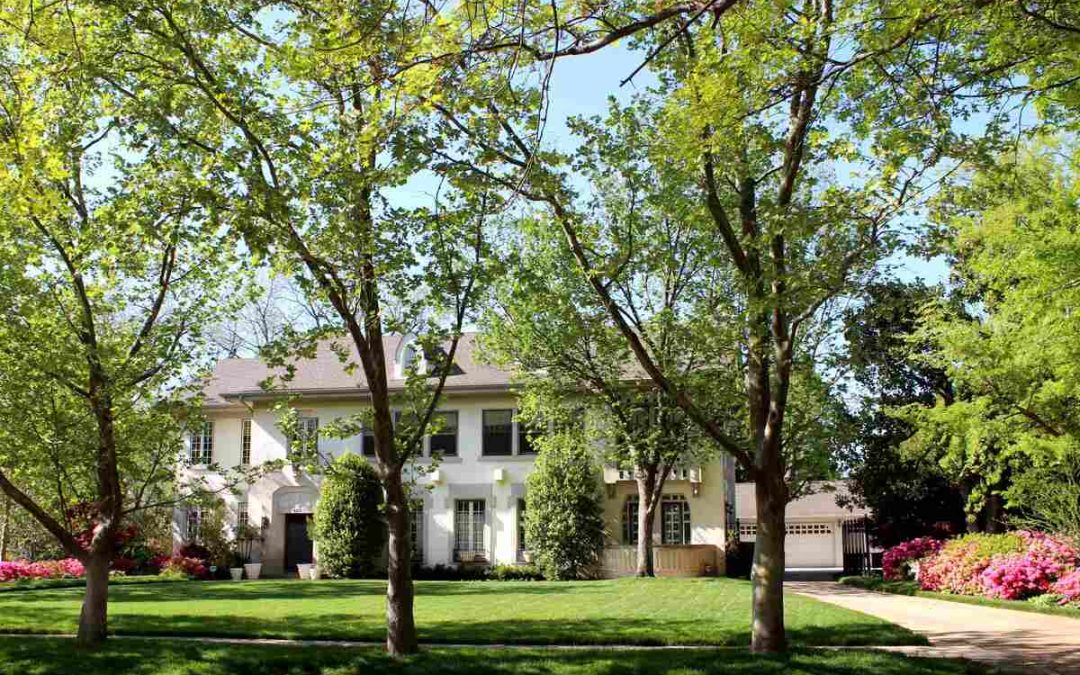Finding the best grass type for your Oklahoma yard can be challenging. The Sooner State falls within the transition zone between warm and cool-season grasses. This means the right grass type for your lawn will be a regional decision, like whether to root for OU or OSU at kickoff.
Hopefully, as you learn more about each grass type, you’ll find choosing the best grass for your lawn to be less contentious than backing an NCAA powerhouse.
In this article, we’ll distinguish between warm and cool-season grasses, identify the best grass type for each state region, and address some frequently asked questions about Oklahoma grass types. Lastly, we’ll connect you with local pros to help you get the most out of your lawn.
In this article:
Warm-Season vs. Cool-Season Grasses
Warm-season grasses thrive in the heat. In Oklahoma, warm-season grasses grow vigorously from mid-spring to early fall. They do best when the air temperature averages between 80 and 95 degrees Fahrenheit.
When temperatures drop, these grasses become dormant and turn brown. Dormancy can begin in the fall and continue until early spring when ground temperatures are consistently below 55 degrees Fahrenheit.
Cool-season grasses are most robust during spring and fall when air temperatures range between 60 and 75 degrees Fahrenheit. In the transition zone of Oklahoma, these grasses will grow new leaves in late winter or early spring. Cool-season grasses enter dormancy in extreme heat and extreme cold.
4 Warm-Season Grasses for Oklahoma
Many Oklahoma lawns contain warm-season grass. These turfgrasses can withstand the heat and drought of the southern plains. The most suitable grass for your lawn depends on your location, soil type, and how much shade your lawn receives.
1. Bermudagrass
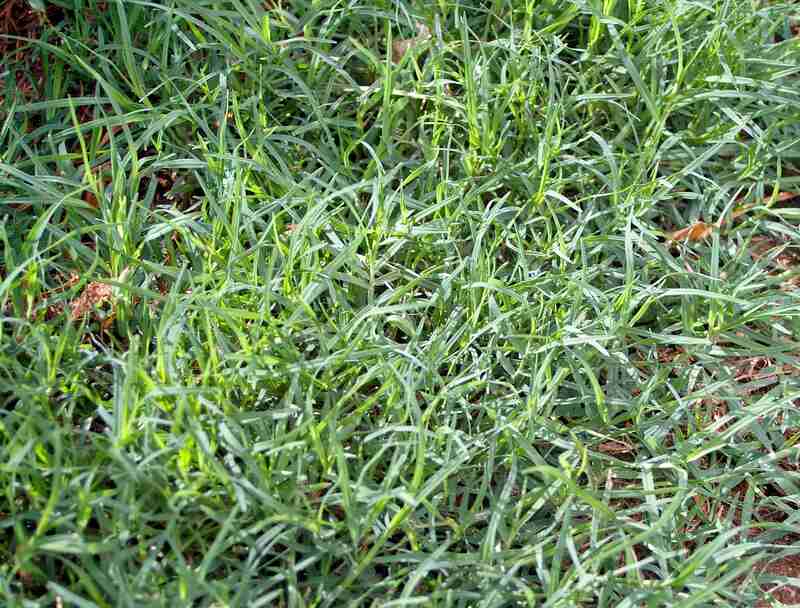
Bermudagrass
Photo Credit: Bidgee / Wikimedia Commons / CC BY-SA 3.0
Bermudagrass is the most popular grass in Oklahoma. This aggressive species spreads rapidly by aboveground (stolons) and belowground (rhizomes) stems. This grass grows only during the warm seasons.
Suitable for lawns, athletic fields, and golf courses, bermudagrass can withstand heavy foot traffic.
Bermudagrass cultivars have a fine texture and a high density. This sun-loving grass has excellent heat and drought tolerance and needs only an inch of water each week during summer drought periods.
Bermudagrass lies dormant when temperatures dip below freezing but revives when warmer weather returns. Bermudagrass can be overseeded with perennial ryegrass for an extended green period as temperatures drop.
A healthy bermudagrass lawn depends heavily on sunlight. A full seven-hour day of sunlight is recommended. Shaded areas around trees or between houses will begin to thin without plentiful sunlight. However, there have been recent developments in bermudagrass varieties that require 4 to 5 hours of direct sunlight.
Bermudagrass is considered a high-maintenance grass because of its aggressive growth habits, but its ability to withstand heavy foot traffic is great for families who like to throw around the pigskin.
This grass’s sun and water requirements make it suitable statewide.
Classification: Warm-season grass
Spreads by: Stolons and rhizomes
Shade tolerance: Low; thrives in full sun
Drought tolerance: High
Foot traffic tolerance: High
Maintenance needs: Needs frequent mowing due to fast growth rate; develops thatch easily; needs regular fertilization
Mowing height: Set the mowing height between 0.5 and 1.5 inches for hybrid Bermudagrass cultivars. Mow common Bermudagrass down to 1.5 to 2.5 inches.
Potential for disease: Good resistance to disease, although diseases are common; low resistance to insects
Soil pH: 6-6.5
Soil type: Tolerates most soil types
Other notes: Keeping weeds under control is essential. Take action to control weeds when you anticipate weed problems.
2. Buffalograss
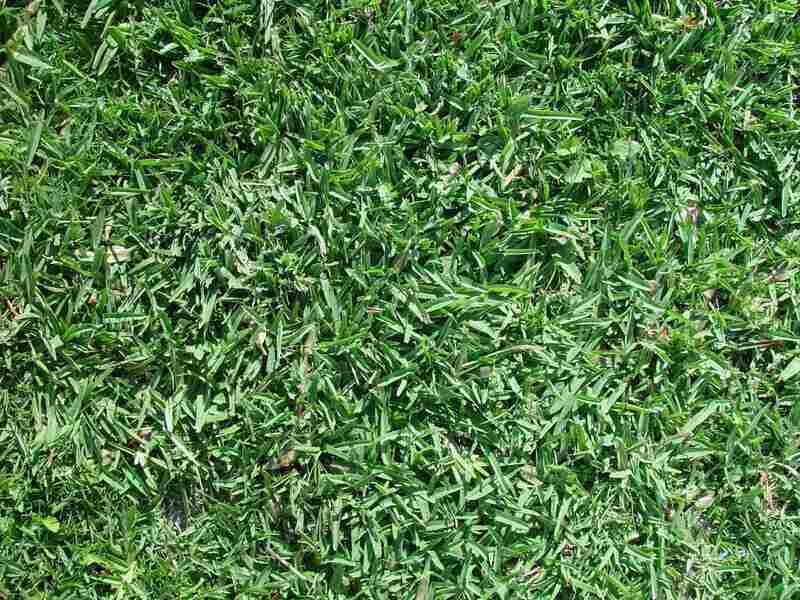
Buffalograss
Photo Credit: Pixnio
Buffalograss is a warm-season, sod-forming native prairie grass ideal for Oklahoma’s prairies. Grayish-green in color, with a fine texture, this grass has excellent tolerance for the heat, drought, and winter conditions of Oklahoma.
Buffalograss grows best in areas of Oklahoma with 12 to 25 inches of rainfall annually and where the grass is exposed to full sun.
This grass tolerates alkaline soil but grows best on heavy-textured soils of Western Oklahoma’s unirrigated lawns. Buffalograss produces numerous seed heads that may disrupt the turf’s overall appearance.
Because buffalograss grows slowly and requires less fertilizer than other grasses, it’s a good choice for homeowners looking for a low-maintenance lawn that requires less mowing.
This grass can be established from seed or sod. Buffalograss performs best in Western Oklahoma.
Classification: Warm-season grass
Spreads by: Stolons
Shade tolerance: Low
Drought tolerance: High
Foot traffic tolerance: Low
Maintenance needs: Low fertilizer and mowing needs. Requires weed control.
Mowing height: Set the mowing height between 2 and 3 inches.
Potential for disease: Good tolerance against diseases and insects
Soil pH: 6.5-7.5
Soil type: Native clay soils, not sandy soils
Other notes: This grass is low maintenance; overmanagement can damage it.
3. Zoysiagrass
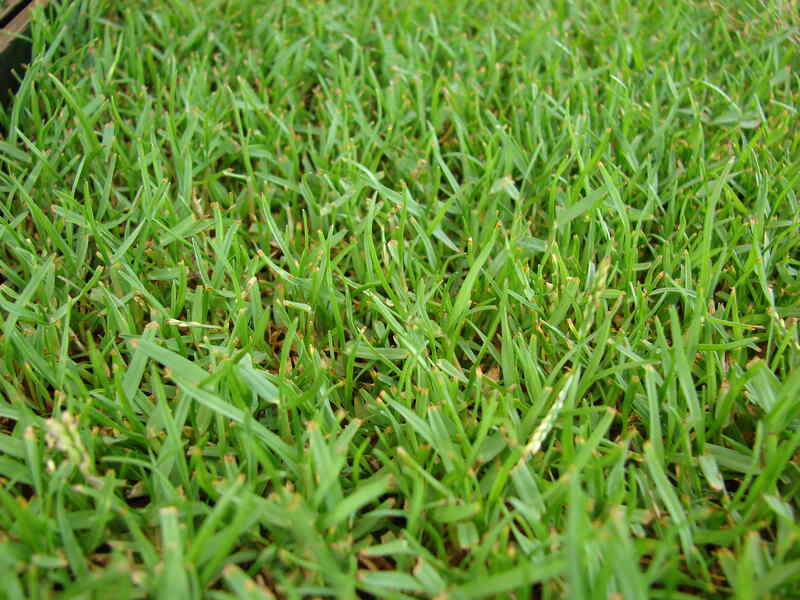
Zoysiagrass
Photo Credit: Forest and Kim Starr / Flickr / CC BY 2.0
Zoysiagrass is dense, warm-season grass with a fine to medium texture. It is the toughest warm-season grass due to its resistance to heat, cold, drought, heavy foot traffic, and ability to grow in light shade. While it requires more maintenance than other grasses, well-irrigated lawns yield the best results.
Zoysia grass is a moderately high-maintenance grass best suited to people who enjoy regular lawn care and have time to dethatch periodically. Zoysia’s dense growth protects against invasive weeds, but this dense growing habit also accumulates excess thatch.
Zoysiagrass is best suited for Eastern Oklahoma.
Classification: Warm-season grass
Spreads by: Stolons and rhizomes
Shade tolerance: Moderate
Drought tolerance: Moderate to High
Foot traffic tolerance: High, but recovers slowly from damage
Maintenance needs: Low nitrogen fertilization requirements, although it’s prone to thatch build-up.
Mowing height: Set mowing height between 1 and 2 inches.
Potential for disease: Good disease tolerance overall
Soil pH: 6-6.5
Soil type: Well-draining, some cultivars are more tolerant of a wide range of soils than others.
4. St. Augustine
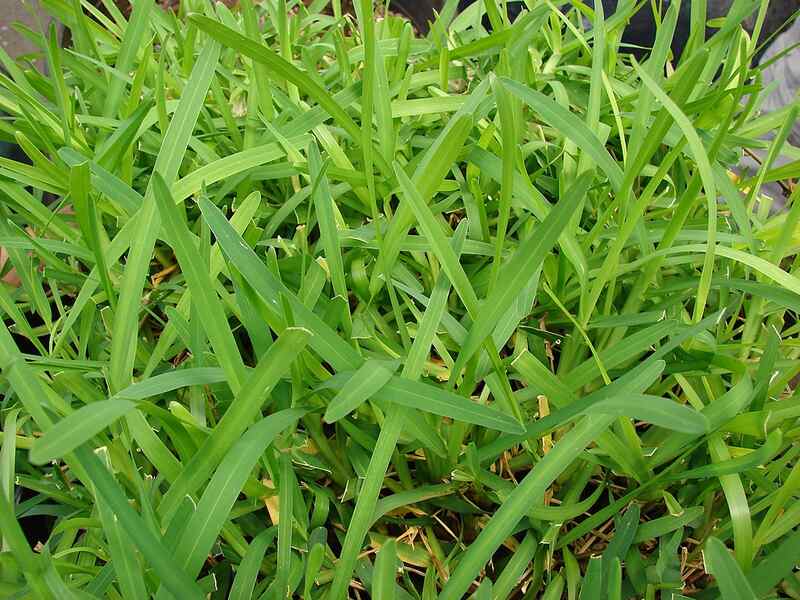
St. Augustine
Photo Credit: Forest & Kim Starr / Wikimedia Commons / CC BY 3.0 US
St. Augustine grass blades are coarse and distinct. This grass grows well in tropical and subtropical climates. St. Augustine grass is vegetatively propagated, which means it can only be planted as sod or grass plugs.
You can use St. Augustine grass plugs if sod isn’t an option for you. St. Augustine plugs are used to fill in bare spots in your lawn by “plugging” turf into them. These plugs can also be used for starting new lawns.
St. Augustine lawns are suitable for homeowners with shaded lawns. This grass grows best in the extreme southeastern parts of Oklahoma.
Classification: Warm-season grass
Spreads by: Stolons
Shade tolerance: Moderate. It is the most shade-tolerant warm-season grass.
Drought tolerance: Moderate to High
Foot traffic tolerance: Low
Maintenance needs: Needs frequent mowing due to fast growth rate; develops thatch easily; needs regular fertilization.
Mowing height: Set the mowing height between 3.5 and 4 inches.
Potential for disease: Moderate to high
Soil pH: 6-7.5
Soil type: Tolerates many soil types; prefers moderately fertile and moist (not waterlogged) soils; doesn’t tolerate soil compaction
Other notes: A low-maintenance coastal favorite, St. Augustine tolerates saline soils and regular foot traffic.
3 Cool-Season Grasses for Oklahoma
1. Kentucky Bluegrass
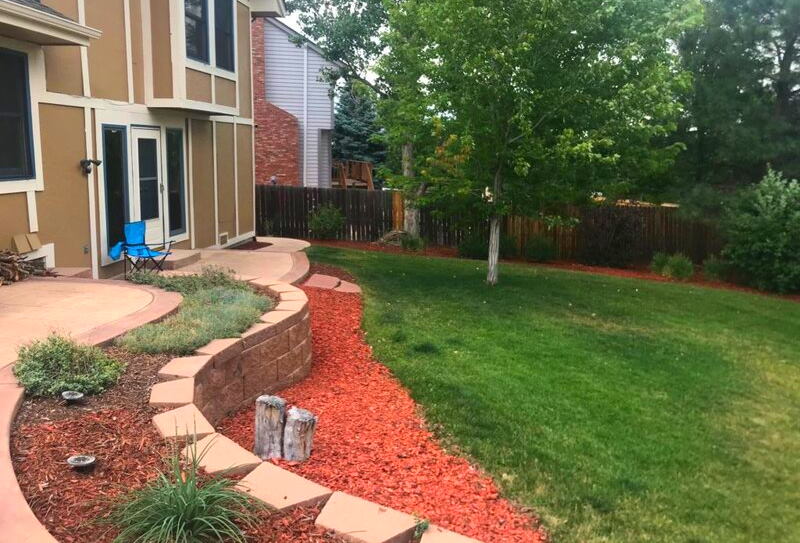
Kentucky Bluegrass
Photo Credit: Brenda Ryan / Wikilawn
Kentucky bluegrass is a resilient and attractive species found on many residential lawns, institutional grounds, parks, and athletic fields. The leaves of this species have a medium to fine texture and deep green color when adequately fertilized.
Compared to most other cool-season turfgrasses, KBG has extensive underground stems called rhizomes, which are suitable for sod production and have a superior recuperative capacity.
Kentucky bluegrass is cold tolerant, moderately heat and drought tolerant, and withstands foot traffic well.
KBG will remain dormant when hot and dry, but grows fervently in spring and fall. When cooler temperatures arrive and soil moisture is sufficient, it’s quick to spring to life.
Kentucky bluegrass is best suited for lawns in Northern Oklahoma.
Classification: Cool-season grass
Spreads by: Rhizomes
Shade tolerance: Low
Drought tolerance: Moderate
Foot traffic tolerance: Moderate
Maintenance needs: Moderate mowing frequency and high fertilization needs.
Mowing height: Set mowing height between 2.5 and 3.5 inches.
Potential for disease: Moderate to high; prone to several diseases, such as dollar spot, leaf spot, necrotic ring spot, summer patch, and stripe smut.
Soil pH: 6-7.5
Soil type: Performs best in well-drained, heavy soils with high fertility.
Other notes: Develops a moderate level of thatch over time. Plan to dethatch every few years.
2. Tall Fescue
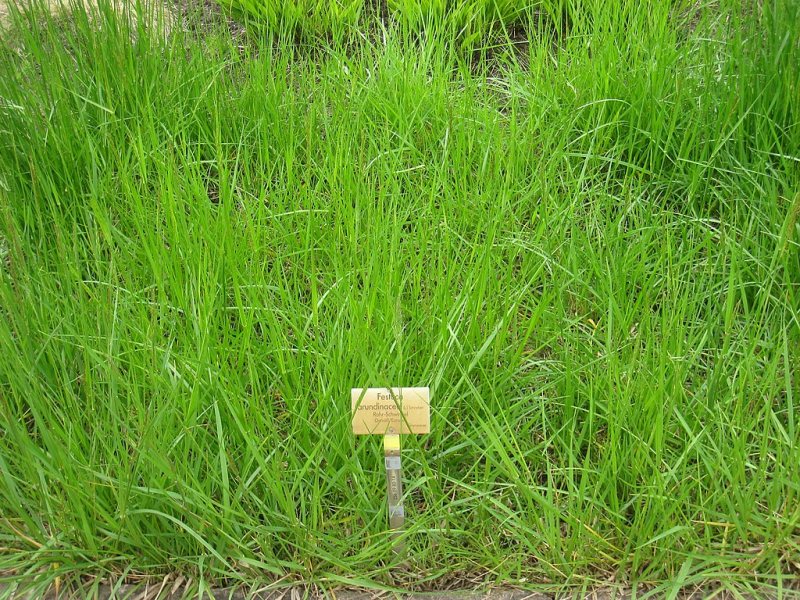
Tall Fescue
Photo Credit: Daderot / Wikimedia Commons / Public domain
Improved turf-type tall fescues are gaining popularity as an additive in the state’s southern regions with moderate shade conditions. In southern Oklahoma, it’s often mixed with sun-loving grasses for full coverage, even in the shade.
Tall fescue is suited to a wide range of soils and climates but performs best in well-draining clay soils in Oklahoma.
When properly watered and fertilized, tall fescues retain their color during winter and provide year-round green lawns.
Tall fescue is an excellent choice for shaded areas. It prefers full sun, but if your lawn has shaded areas, tall fescue may provide more resilience than KBG. Tall fescue grows well statewide.
Classification: Cool-season grass
Spreads by: Produces short rhizomes but has a bunch-type growth habit
Shade tolerance: Moderate
Drought tolerance: Moderate to High
Foot traffic tolerance: Moderate
Maintenance needs: Frequent mowing. Does not produce significant thatch.
Mowing height: Set mowing height to 2 inches when grass reaches 3 inches tall.
Potential for disease: Tolerant of most diseases when properly maintained.
Soil pH: 5.5-6.5
Soil type: Adapted to a wide range of soil conditions, but prefers fertile clay soils with good drainage.
Other notes: The right mowing, fertilization, watering, and sun/shade conditions can help minimize disease pressure on your turf.
3. Perennial Ryegrass
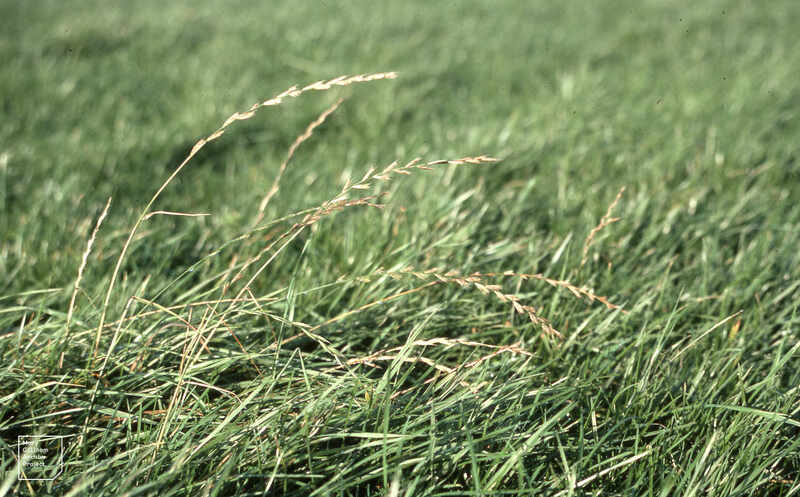
Perennial Ryegrass
Photo Credit: Dr Mary Gillham Archive Project / Flickr / CC BY 2.0
Even though perennial ryegrass naturally suits northern states, its widespread use in southern lawns is a phenomenon. Winter brings dormancy and browning for warm-season grasses in the south and west. Lawn owners in Oklahoma keep their lawns green in winter by overseeding perennial ryegrass into their warm-season lawns in the fall.
During winter, fast-germinating perennial ryegrass provides a temporary green lawn. Once warm-season grasses take over and summer heat returns, it dies out. Its fast germination rate and quick establishment make it one of the most popular fine-bladed grasses.
This grass is used throughout the state for soil stabilization and winter color. If grown as a lawn’s main turf, it will perform best in Northern Oklahoma.
Classification: Cool-season grass
Spreads by: Has a bunch-type growth habit
Shade tolerance: Low
Drought tolerance: Low
Foot traffic tolerance: High
Maintenance needs: Moderate mowing and fertilization requirements. Thatch is not significant.
Mowing height: Set mowing height to 1.5 to 2.5 inches
Potential for disease: High. Common diseases include gray leaf spot, red thread, and leaf spot/melting-out.
Soil pH: Can grow in soils with a pH between 5 and 8, but prefers between 6 and 7.
Soil type: Prefers good drainage and fertility, but can tolerate some poor drainage.
Other notes: In comparison to other cool-season grasses, it produces less thatch.
FAQ About Oklahoma Grass Types
When’s the best time to seed Tulsa lawns with cool-season grass?
Late September and October are the best times to plant cool-season grasses. Planting these grasses any later makes them prone to frost, interfering with germination. You can plant grass seeds in early spring if you miss the September-October planting window for cool-season grasses.
What grass stays green year-round in Oklahoma?
Tall fescue is one of Oklahoma’s most popular cool-season grasses thanks to its high heat tolerance. Tall fescue needs lots of water to thrive, but with ample irrigation and fertilizer, tall fescue can remain green all year round.
What’s the best grass to grow in Western Oklahoma?
The best turf for Western Oklahoma is buffalograss. Suitable for unirrigated lawns and general turf areas, this grass produces numerous seed heads, which can distract from the turf’s overall appearance. Buffalograss lawns can be started by seed or by sod.
What is the best grass to grow in Tulsa?
The best grass types for Tulsa lawns include:
- Bermudagrass
- Zoysiagrass
- Kentucky Bluegrass
- Tall Fescue
What is the best grass to grow in OKC?
The best grass types for Oklahoma City lawns include:
- Bermudagrass
- Zoysiagrass
- Buffalograss
- St. Augustinegrass
- Tall Fescue
- Kentucky Bluegrass
- Perennial Ryegrass
Choosing Plant and Grass Varieties for Your Oklahoma Landscape
Here are some tips to keep your lawn lush and healthy:
- Sunlight: Some grasses are more shade-tolerant than others. A yard with abundant sun is perfect for Bermudagrass, while tall fescue is great for shaded lots.
- Foot traffic: If you have kids or use your lawn to entertain, you’ll need a lawn that withstands heavy foot traffic. Bermudagrass, zoysiagrass, tall fescue, and perennial ryegrass are strong contenders for high-traffic lawns.
- Maintenance: Some grasses require more maintenance and care than others.
Need to hire a lawn care pro near you to get the best out of your Oklahoma grass? We have trusted professionals in Tulsa, Oklahoma City, and many other cities throughout the state.
Main Image Credit: Lawn, Oklahoma / MARELBU / Wikimedia Commons / CC BY 3.0

